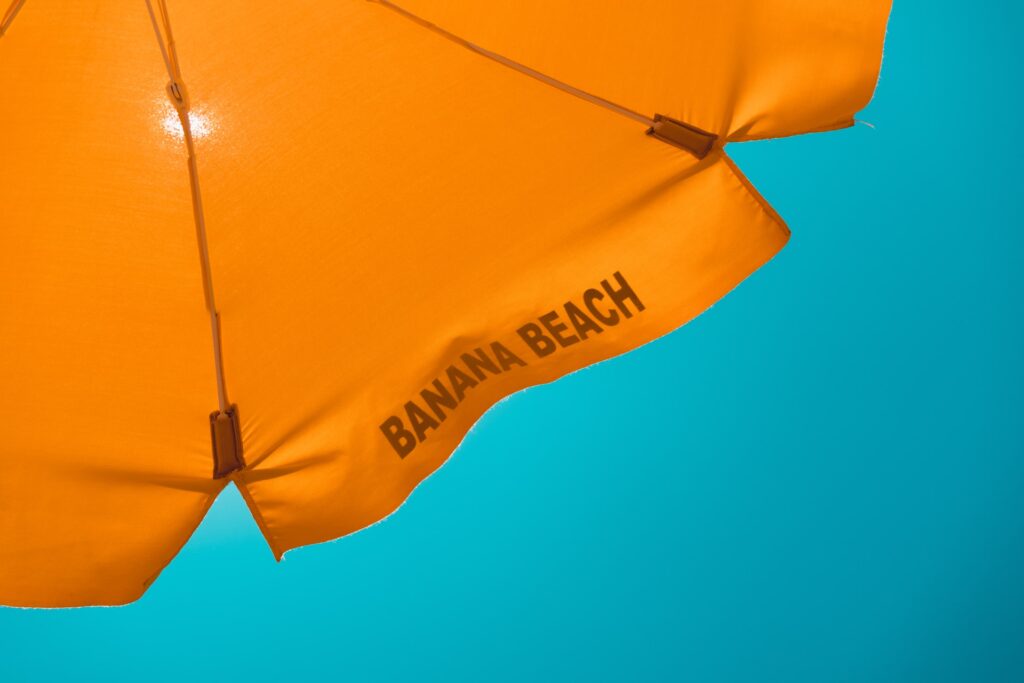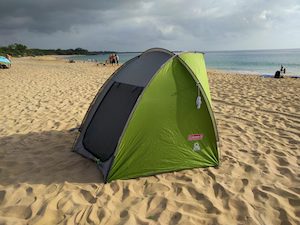What is a beach shade UPF rating? Why is it important? When it comes to beach shades, choosing the right fabric really matters. Not all fabrics offer the same level of protection from the sun’s harmful ultraviolet (UV) radiation. If the main purpose of your beach shade is to prevent sunburn and help you stay safe at the beach, evaluating the fabric your beach shade uses is an important part of making a beach shade selection.

Image credit: Daniel Hansen on Unsplash
UPF – Ultraviolet Protection Factor
For increased safety at the beach, the amount of protection a beach shade fabric offers should be a core consideration. Protection levels offered by specific fabrics are quantified by a fabric’s UPF (Ultraviolet Protection Factor). The UPF rating of a fabric designates how much of the sun’s ultraviolet radiation is blocked by the fabric. UPF ratings represent the ratio of UV radiation that is blocked by the fabric.
For example, a fabric with a UPF 40 rating means that if 40 units of UV fall on the fabric, only 1 unit will pass through. Therefore, a UPF 40 fabric blocks 39 out of 40 units of UV, or 97.5% of the UV. Higher UPF ratings mean that the fabric blocks more of the UV from the sun than lower UPF rated fabrics.
For clothing and UV Protective textiles, the American Society for Testing and Materials (ASTM) has released the following categories for UPF protection ratings:
| UPF Rating | Protection | UV Radiation Blocked |
|---|---|---|
| UPF 15-24 | Good | 93.3% – 95.9% |
| UPF 25-39 | Very Good | 96.0% – 97.4% |
| UPF 40-50+ | Excellent | 97.5% – 98+% |
Fabric Types
Different types of fabric offer different levels of UV protection and therefore have different UPF ratings. For beach shades, the UPF rating is often published, and can be reviewed as you choose which beach shade to buy.
Why is it important to look up the UPF rating? Although there is some correlation between what percentages of visible light pass through a fabric and the UV that passes through, it is not a strong correlation. What this means is that even though a fabric may look like it is providing a lot of shade, that doesn’t necessarily mean that a lot of UV is also being blocked. Only by studying the UPF rating can a fabric’s efficacy be evaluated.
When a UPF rating is not available for the product, consider contacting the manufacturer for more information – the rating may be known, however not published in promotional material. Otherwise, here are some general guidelines for evaluating a potential fabric.
- Weave – Tighter weave fabric is better than loose. Tightly-woven, less open fabrics generally offer better protection than light, loose, or stretchy fabrics.
- Color – Dark-colored fabrics offer more protection than lighter-coloured fabrics, according to a study at the University of Alberta.
- Type – Polyester fabrics contain a benzene ring that can absorb UV light, and so can offer improved UV blocking.
Consider as well what treatments or chemicals may have been applied to a beach shade fabric to assist its UV protection. Fabric treatments exist that greatly enhance the UV protection offered by a fabric. Be sure to take a look at what treatments a beach shade manufacturer may have applied to their product. If a scientifically measured UPF rating isn’t available, there may at least be information about the fabric treatments that have been applied.
Beach Shades UPF Ratings Above 40
Are there beach shade options that offer UPF ratings of 40 or higher? Yes! Here are just a few of them to get you started:
| Model & Type | Advertised UPF Rating |
|---|---|
| Neso Tents Gigante Beach Tent (paid link) Beach Canopy (11ft x 11ft) | UPF 50+ |
| Coleman Beach Shade Beach Tent (paid link) | UPF 50+ (see my review) |
| SUN NINJA Pop Up Beach Canopy (paid link) Beach Canopy | UPF 50+ |
Note: As an Amazon Associate I earn from qualifying purchases.
